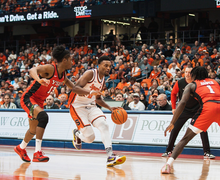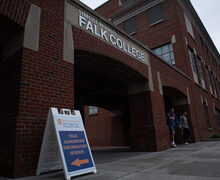Larger Than Life
Toothpick City II is on display at the MOST as part of a traveling exhibit. The city features model temples and towers, including Burji Dubai, the tallest building in the world.
IF YOU GO What: Museum of Science and Technology Where: 500 South Franklin St. When: Wednesday-Sunday, 10 a.m. to 5 p.m. How much: $2-$11 If you go to the MOST, make sure you wear socks. The museum’s five-story Science Playhouse is one of its most used and exciting attractions, but some people who come can’t enjoy it, said Jennifer Noble, a museum host supervisor.
‘(The playhouse) is one of the most popular parts (of the museum) for adults,’ Noble said. ‘They like playing in the playhouse, too. Sometimes they’re reluctant to, but when they go in, they feel like a kid again. But you can only go in if you are wearing socks.’
The Milton J. Rubenstein Museum of Science & Technology is located in downtown Syracuse, near Armory Square. It is a hands-on museum, which Noble said is mostly used by children. But many students and other adults use and enjoy the museum as well.
Out of the many exhibits worth looking at, the museum’s model of the human body is a must-see.
The museum brings every part of human anatomy alive, starting with the heart. Visitors follow the sound of a beating heart as they walk through a giant replica with touchable arteries and veins.
There is also a larger-than-life brain that uses lights and buttons to highlight parts of the brain used for specific actions. The exhibits get more lifelike from there. The human nose sneezes on museum visitors, with nose hairs bristling with the effort. Sadly, the tongue doesn’t lick, but the exhibit does teach an extensive lesson on the taste buds you use every day.
Moving away from the human body and into the Earth Science Discover Cave, visitors can crawl through small caverns and see mysterious crystals forming at the bottom of a well. Within the caves are smaller exhibits among the stalactites that discuss the inner workings of Earth. There are also dinosaur bones to be excavated in the sand, if you feel like getting a little dirty.
In the traveling exhibit, the museum simulates world travel through its Toothpick City II, which presents to-scale models of large structures from around the world. These structures include the Burj Dubai, the tallest building in the world, and St. Peter’s Basilica.
Visitors can also take a ride on a motion simulator or watch old-fashioned model trains zoom through mini replicas of old New York towns.
This year the Syracuse University freshman class was brought to the MOST as a part of an introduction to the city of Syracuse right. The students had full reign over the many exhibits of the museum.
‘We do get some students who come,’ said Carissa Evans, a museum host. ‘Sometimes teachers send their students in, and sometimes they just come in for the hell of it, or on dates.’
‘We’re here for fun and for science,’ said Katie Dilks, a marriage and family therapy graduate student who was on a date with a fellow grad student. ‘There’s always cool stuff in places like this and it makes for an out-of-the-ordinary kind of date.’
The couple said they were excited to see the giant heart and they had visited a similar construction in a museum in Philadelphia. Dilks said she was excited to see how the MOST adds up to other science museums.
The MOST has a few attractions that would make for an interesting date. The IMAX Theatre has various shows playing, including ‘Night at the Museum,’ ‘The Human Body’ and ‘The Living Sea.’ The Planetarium can also make a good date at night, with shows, like ‘Summer Sky,’ that take visitors on a voyage through the constellations.
‘I think there are a lot of cool things here that students and adults can enjoy, even if they were originally targeted toward kids,’ Dilks said.
If you are not going on a date, parts of the museum like the planetarium can still be useful to students who can use them as study tool, Evans said.
‘The geology cave and the life sciences area are good for an older crowd,’ Evans said. ‘They have a lot of information that younger kids might not appreciate. They can be good study spaces for students taking classes in those areas.’
Evans said the museum is also creating more adult-targeted exhibits like the Flight exhibit, scheduled to open in November for the holidays.
Published on September 7, 2009 at 12:00 pm





